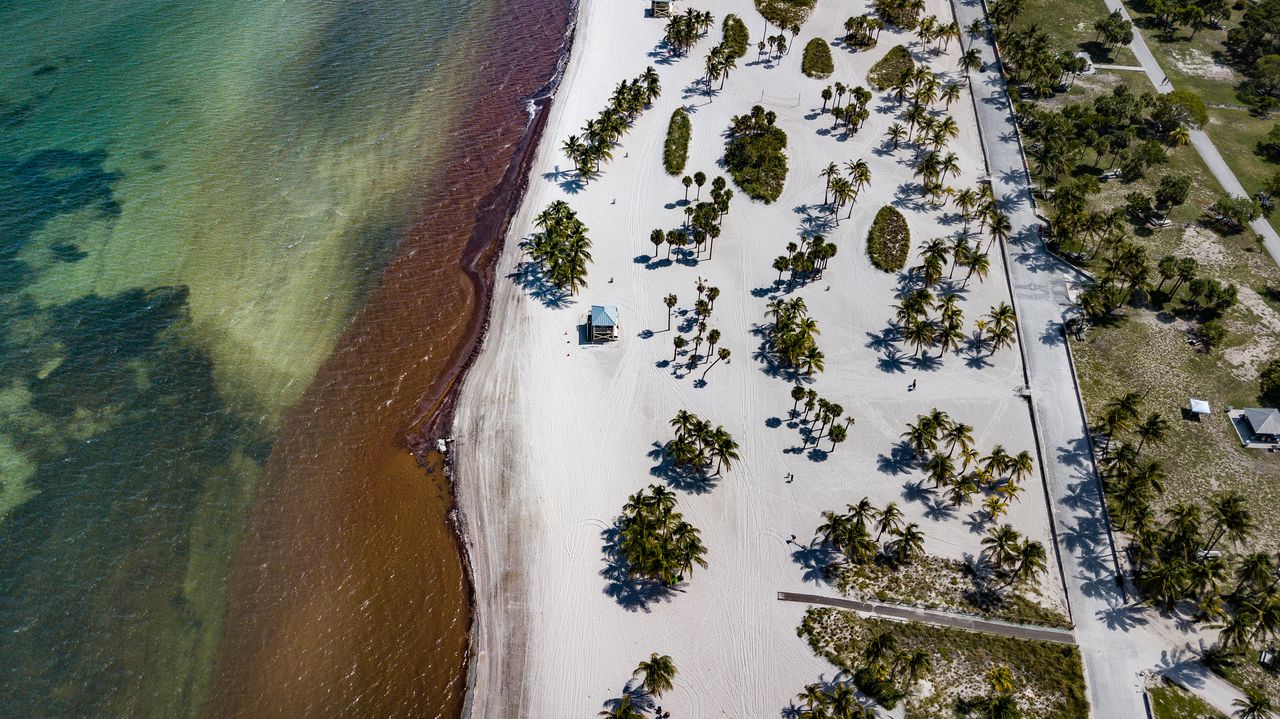For World Oceans Day, we need to talk about the giant seaweed blob taking over Floridaâs waters
Florida’s pristine beaches have long been cherished for their soft sands and sparkling blue waters. But over the last few months, vast quantities of seemingly mysterious seaweed have been washing up on the beaches of West Florida.
The blob, as some have called it, is thousands of miles long and reaches from the coast of West Africa to South America and right up into the Gulf of Mexico.
Known as Sargassum, the seaweed is naturally occurring and very valuable to the various ecosystems it interacts with. However, as the seas have warmed and been awash with various nutrient-rich pollutants, the Sargassum has grown to an alarming size, giving scientists critical clues about the health of our oceans.
Climate change is one of the primary factors contributing to the increased frequency and intensity of Sargassum blooms. Rising ocean temperatures, altered ocean currents, and nutrient imbalances have created ideal conditions for its growth.
Reckon spoke to Amanda Prieto, the director of programs at the Miami Waterkeeper, a non-profit focusing on clean water, thriving habitats and sea level rise resiliency, about the Sargassum.
Reckon: The world’s oceans are facing many challenges right now. But on the east coast, and in Miami in particular, people seem to be focusing on the thousands of square miles of seaweed appearing on the beaches.
Can you tell me a little about that?
Prieto: Sargassum is a naturally occurring type of seaweed and there are lots of benefits to it. It’s an active ecosystem for fish and crabs, and it originates in the Sargasso Sea in the western Atlantic Ocean. But then it drifts thousands of miles and the Gulf eventually picks it up. And that’s how it makes its way to our beaches. So, it’s nothing new. It’s been happening for long periods of time, but what’s new is it’s accumulating in massive quantities that have created a lot of fear.
R: You mentioned the Sargassum has gotten bigger. What role has climate change and other types of pollution, like nutrient-rich fertilizer coming from the Amazon rainforest, played in this?
P: As you know, climate change is not limited in scope locally here in Miami. It’s a global issue because as water becomes warmer, along with nutrient pollution, it contributes to a wide range of problems, including contributing to the massive quantities of Sargassum we’re seeing right now.
Rainforests in general do have an impact on water quality because of what’s released from farms and even logging. So, the Sargassum becomes a sort of petri dish that feeds off the nutrient fertilizer. It can hold pathogens and bacteria particularly when it decomposes on the beaches.
R: What kind of danger does that pose to the public?
P: It releases hydrogen sulfide gas and you shouldn’t have prolonged exposure to it. That’s why cities, municipalities, and counties have management strategies to deal with it. And that’s so it doesn’t accumulate and just sit and decompose on the beach. They have an active strategy that they’re working through.
R: What should the public do if they encounter it?
P: You can step on it but I wouldn’t suggest anyone swim in areas where it’s really dense. But it’s not something that should prevent you from going to the beach at all. It’s not that level of danger.
R: You hinted at this previously, but what else does this mean for the biodiversity of the ocean?
P: Warming oceans are generally bad. But this particular issue, the Sargassum, can prevent sunlight from reaching the seagrass bed which can kill fish and generally prevent those natural ecosystems and habitats from thriving. It affects a lot of things.
R: What about solutions?
P: Again, it’s naturally occurring and there are strong benefits for it. We need it, it’s part of the ecosystem and it provides habitat for small fishes. What needs to be done and what we are involved in is management practices and the challenges municipalities and stakeholders are having. We’re actually working on a white paper right now. One key area of research is working out if there are renewable methods to deal with it once it’s reached the beaches, especially in large quantities. There’s a large amount of research on composting, for example, and whether that might be a viable solution, but it’s still pretty new in terms of research.
R: Typically, the public doesn’t react to environmental issues they can’t see. The Sargassum is huge and visible. Is this an opportunity to educate or are we still managing fear?
P: I think there’s a lot of fear and some of it may be exaggerated. But I also think it’s really important that when we reach out to residents and communicate and help them understand what their level of concern should be, what they need to be aware of, and how their actions can affect water quality. So even if the Sargassum is coming from the Sargasso Sea and is not necessarily being created here, it is ending up here and is bigger because of how we treat the environment. Fertilizer ordinances and other things that can reduce nutrient pollution here are going to affect other areas as well. Every little component and piece is important.
R: What’s next for Miami Waterkeeper?
P: We’re involved in a lot of really great projects.
For example, we have a really exciting grant from the EPA on green infrastructure and we are currently researching how that can be implemented in urban areas, specifically where environmental justice is needed. It could be something as simple as a rain garden, or wetlands around the canal bank, and just doing research on different types that can be designed to help with stormwater retention and drainage and improving tree canopy. It also includes a really high level of community engagement as well, which we’re very happy about.
